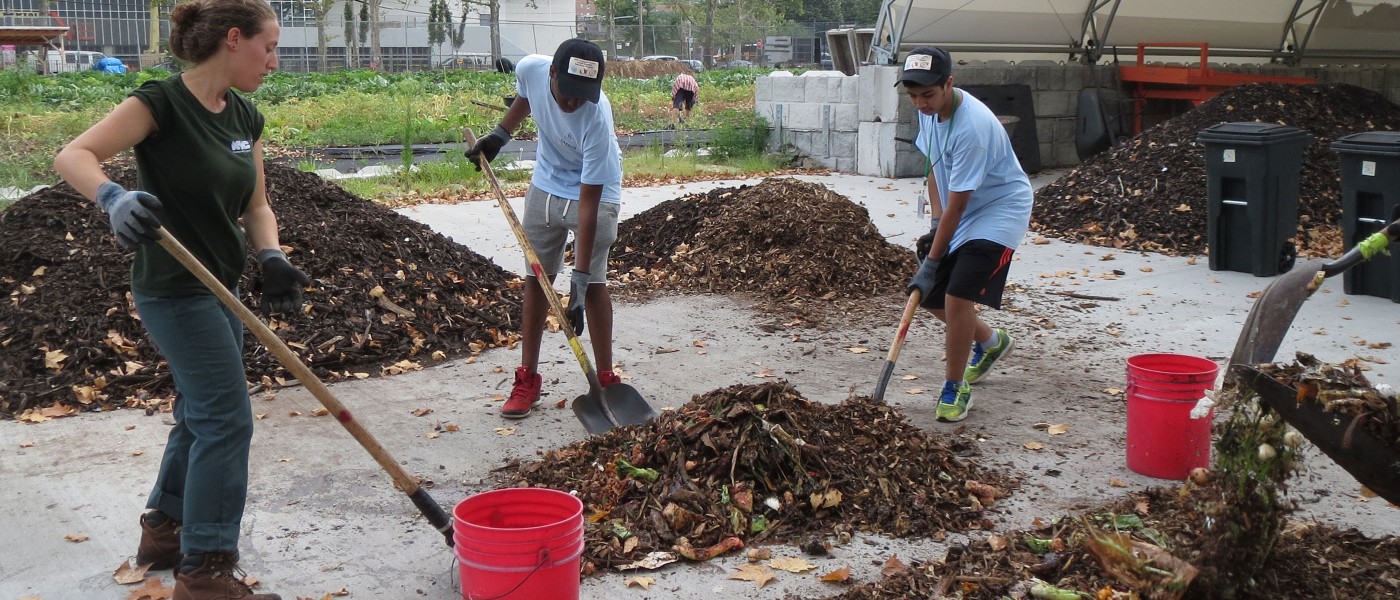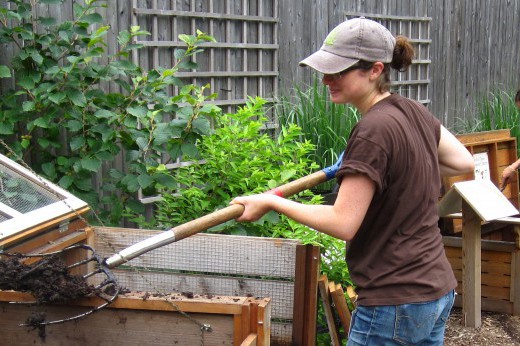Feed the soil, not the plant. According to this fundamental principle of organic crop nutrition, soil is a living community that requires nurture. And well-nurtured soil in turn nurtures the plants that are part of it.
The primary food that soil needs is organic matter, and compost is the best way to provide it. You can feed plants through other means, but giving your soil compost is like feeding your family bread instead of a pile of flour and water, which after all contains the same nutrients.
What is Compost?
Soil health is indivisible from humus, the main component of compost. If a soil's fauna is vital and active, it will go to work breaking down raw organic matter—the waste products or remains of other organisms. Once organic matter has undergone some degree of decomposition, it can become humus, a dark brown, porous, spongy, somewhat gummy and pleasantly earthy-smelling substance.
Humus is actually a generic term for a substance that varies widely in its chemical characteristics, depending on the nature of the original material and the conditions of its decomposition. Each kind of humus is a complex mixture of biochemical compounds in a colloidal or gel-like form, including plant waxes and lignins, and the gums and starches transformed by bacteria and fungi as they break them down. By building humus, these soil denizens improve soil's physical and chemical properties as well as its biological health.
Promoting Good Tilth
Soil that has good physical qualities is said to be in good tilth. This means that it has good structure, and readily allows both air and water to enter and leave, while retaining enough of each to meet the needs of its inhabitants. It is easy to work using garden tools and presents little resistance to growing plant roots. Soil in good tilth resists erosion, holds water in time of drought, and holds enough air to prevent plants from drowning when it rains heavily. Although many people think first of plant nutrients when they think of soil fertility, tilth is at least as important—many fertility problems can be helped more by improving tilth than by adding fertilizers. Compost is the supreme soil conditioner, and will help improve structure that is either too light or too heavy.
Good soil structure is created by the formation of aggregates—irregularly shaped particles that stick together with lots of gaps and pore spaces between them. Soil with good structure will keep its shape after you squeeze it in your fist, but easily fall apart when you drop it. The gummy, spongy texture of humus is essential to forming aggregates and creating the crumb structure that establishes ideal conditions for biological activity. These aggregates hold air in the pore spaces, and each particle is covered with a thin film of water. Good soil structure means good drainage, as the spongy humus soaks up excess water and prevents roots from drowning, while water is able to drain out gradually through the pore spaces.
In dry times these pore spaces also serve a critical function by enabling moisture in lower levels of the soil to be wicked up to plant roots through a mechanism known as capillary action. Because humus can hold 80 to 90 percent of its own weight in water, it also serves as a reservoir that plants can use when they need it. It should come as no surprise that scientific research confirms that soil high in humus helps crops better withstand drought conditions.
Good structure also means good aeration, a necessity often overlooked in the quest for improved fertility. Most beneficial soil organisms, especially plant roots, need plenty of air to grow. This is one reason why cultivation often stimulates a flush of new plant growth, because more air is worked into the soil and more plant nutrients are released from organic matter—mineralized—as soil organisms grow faster. The same principle is at work when you turn your compost pile, making the organisms convert raw organic matter into humus more quickly.
In addition to improved air and water availability, the large amount of surface area of soil aggregates offers plenty of opportunities for the chemical interactions to take place that make nutrients available to soil organisms and to plants. So good soil structure provides an ideal habitat for soil organisms, with lots of places for them to live where they can get everything they need.
Fertilizing Soil—Slowly
Compost not only conditions soil but acts as a slow-release plant fertilizer. Calculations of nutrient values on fertilizer bags show only the amounts of soluble nitrogen, phosphorus and potassium immediately available to plants—and a bag of compost sold as fertilizer would have very small numbers on its label. But while it may be low in soluble nutrients, compost contributes in a major way to soil and plant nutrition as it is further broken down over time by soil organisms to release nutrients when plants need them. This slow release of nutrients has many advantages. Foremost is that while highly soluble fertilizers can easily dissolve in rainwater and wash away from the garden—threatening the health of nearby ground- and surface-water—the nutrients provided gradually by compost are taken up by plants as they are released, and so are not wasted. If excessive amounts of nutrients are available to plants from highly soluble fertilizers, plants may take up more nutrients than they need; excess nitrogen in particular is undesirable because it creates lush, watery growth that is more susceptible to attack by pests and diseases. Aphids, for example, are attracted to plants with high levels of nitrogen in their leaves.
In addition to major plant nutrients, compost is rich in a well-balanced mix of micronutrients or trace elements, essential players in the molecular interactions on which all living organisms—including people—depend. While you can provide plants with other sources of these nutrients, the safest and most reliable way to provide them is through the compost pile. Plants need only tiny amounts of micronutrients, and too much of any of them can be harmful. Living tissue generally contains a good balance of micronutrients, so when it decomposes, its nutrients are made available in just the right proportions to feed new organisms.
Humus molecules bind these nutrients into chemical complexes in a process called chelation, which keeps them from washing away but makes them readily usable by plants and microbes. This same mechanism also helps detoxify soil if it is overdosed with essential nutrients, or even when it is contaminated with toxic heavy metals such as lead or cadmium.
Nutrients that plants need can also be stored efficiently on the large surface area of soil aggregates, chemically assisted by the colloids—gel-like substances—in humus. Positively charged nutrients, including calcium, magnesium, potassium and several important micronutrients, are held at these colloidal exchange sites, where they are available when plants need them, but will not be washed away.
Finally, we don't often think about the fact that carbon is really the most important food for plants, because they get most of it from the air in the form of carbon dioxide. However, humus is an important source of carbon for plants as well as for the organisms that consume its carbohydrates directly. As organic matter and humus decompose, carbon dioxide and other carbon-rich substances are released in the area near the soil surface, close to where plants are growing, and can significantly stimulate plant growth in this way alone.
Unlocking Nutrients in Soil
Compost not only is rich in essential plant nutrients, but also helps stimulate the release of nutrients already present in soil but in unavailable forms. The availability of soil nutrients is strongly influenced by the soil's acidity, denoted as its pH. The ideal soil pH of 6.5 is slightly acid. Problems result when soil pH is either too low (acid) or too high (alkaline). Very acid soils can release excess micronutrients in harmful levels and lock up essential phosphorus. Alkaline soils have lots of minerals, but they are often locked up in chemically insoluble forms. Humus moderates both low and high pH, a quality known as buffering, and so improves the availability of nutrients in both acid and alkaline soils.
Compost also works biologically to improve nutrient availability. Its rich diversity of microbes goes to work on rocks and decay-resistant organic materials, unlocking nutrients such as phosphorus for use by plants. Certain kinds of fungi, called mycorrhizae, actually form symbiotic relationships with plant roots, exchanging phosphorus extracted by the fungi from rock particles for carbohydrates produced by the plants.
Fighting Pests & Diseases
The value of compost goes beyond improving soil structure and providing nutrients. Soil health is, as we've seen, directly related to plant health. And, as is true of healthy people, healthy plants are better able to resist attack by pests and disease-causing pathogens. The right balance of nutrients, released at the rate at which they are needed by plants, helps prevent disease and insect problems, such as those caused by excess nitrogen. Compost also works directly to protect plants from soil-borne pathogens by inoculating them with organisms that fight disease. It is no accident that most antibiotics are derived from microorganisms that can be found in healthy soil. Compost tea, sprayed directly on crop leaves, has also been found to prevent certain fungal diseases such as mildew, and researchers are now able to produce custom composts that can suppress specific disease-causing organisms such as Pythium, a fungus that kills seeds and seedlings before or as they emerge from cool, wet soils (a widespread disease called damping-off).
In sum, compost is the ultimate all-around garden elixir. It won't work miracles, but a diet of compost will replenish and increase the life in your soil, and keep your plants in the best of health.



